![]()
![]()
![]()
Use LEFT and RIGHT arrow keys to navigate between flashcards;
Use UP and DOWN arrow keys to flip the card;
H to show hint;
A reads text to speech;
53 Cards in this Set
- Front
- Back
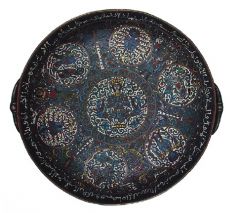
alexander plate
|
* atabeg (1100-1300) - artuqid
* comissioned for or by an artuqid prince, bears his name and titles in both arabic and persian. made in georgia. * enameled cloisonne. byzantine technique. * subject matter/iconography is mixed. alexander the great's ascension into heaven, "self engineering his apotheosis" via griffins. also has dancing girls, eagles, etc. but not whole princely entertainments. taking bits and pieces from different cultures. |
|
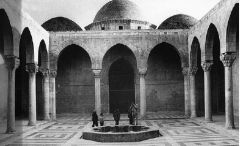
al-firdaus mosque and madrassa
|
* atabeg (1100-1300)- saljuks of rum (1235-1236)
* aleppo, syria * saljuks of rum employ armenian architects, but maintain great saljuk tendencies of state architecture (to emphasize power) , princely duties, minor arts. state sponsored royal school. patrons: royal women- type of dowry/currency. decoration becomes musch more limited but stone carving is typical of saljuks of rum. |
|
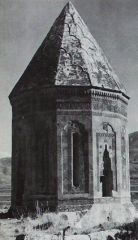
gevas tomb tower
|
* atabeg (1100-1300) - saljuks of rum (around 1300)
* gevas, turkey * royal princess. armenian architecture put into the service of saljuks of rum. muqarnes vaulting. different in scale. people in power adapting other groups ideas. |
|
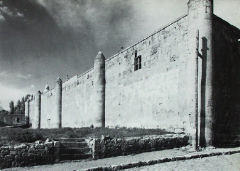
tercan caravanserai
|
atabeg (1100-1300)
* tercan, turkey * silk road and slave trade. visual expressions of power. monumental in scale. change: caravanserais have religious focus, and no quasi-defensive aspects, actually functional. * great saljuk caravanserais: contrast with umayyads, use rather than display. no more fake militaristic features. |
|
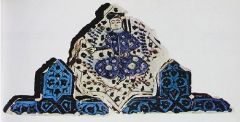
star tiles (quabadabad)
|
* atabeg (1100-1300) - saljuks of rum
* qubadabad royal palace of the sultanate in konya, turkey * shape of tile, part of decoration, mineral colbat- expensive recourses of anatolian plateau. democratization of the image- seated ruler, generic. |
|

royal niche (sinjar)
|
* atabeg (1100-1300)
* sinjar, iraq * ruler seated in royal niche, muqarnes vaulting forms canopy over head. pre existing religious form, religious/secular use, "slaves" : mamluks. most sacred space in mosque becomes emblem of secular power. little figures of court officers decorating the edges. |
|
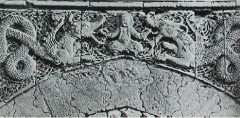
talisman gate
|
* atabeg (1100-1300)
* baghdad (now destroyed) * serpent/griffin. snakes become symbolic of power. influence from the east. now using haloes for rule/power, no sacred value. apotropaic: prevent evil, also protect from evil |
|
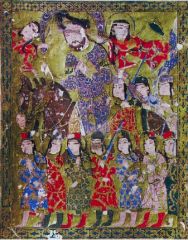
book of songs
|
* atabeg (1100-1300)
* secular texts, popular texts that pre-exist atabegs, written down and illustrated for the first time ever. workshops producing 20 volume set of book of songs. show of wealth. use of hieratic/hierarchic scale. haloes, tiraz (name on tiraz is his own name, identifier). byzantine influence angles? or roman victory figures? important people in this period: horseman. mounted armies, anatolia. members of the court wearing distinctive and lavish dress. upper nobility- not ruler. visual bring adapted by non-rulers. base material of entire piece is gold leaf. frontispiece of volumes. implements of power from all cultures. bright colors characteristic of this period. |
|
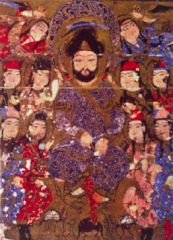
book of songs
|
* atabeg (1100-1300)
* secular texts, popular texts that pre-exist atabegs, written down and illustrated for the first time ever. workshops producing 20 volume set of book of songs. show of wealth. use of hieratic/hierarchic scale. haloes, tiraz (name on tiraz is his own name, identifier). byzantine influence angles? or roman victory figures? important people in this period: horseman. mounted armies, anatolia. members of the court wearing distinctive and lavish dress. upper nobility- not ruler. visual bring adapted by non-rulers. base material of entire piece is gold leaf. frontispiece of volumes. implements of power from all cultures. bright colors characteristic of this period. |
|
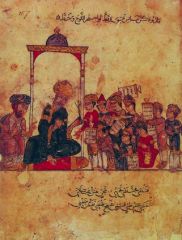
maqamat
|
* atabeg (1100-1300)
* popular novel- no illustrations pre-atabeg.abu zaid shown in image and words beneath. lower class- mass produced. traveler who tries to do different jobs, preacher teacher- but he is a "fool." |
|

ayyubid brass basin
|
* atabeg (1100-1300) - ayyubid
* ayyubids have most interaction with crusaders. metalwork extremely unique. brass with silver inlay. statement of wealth for middle or upper middle class- shows the rise of this class. wealth of patron discussed in inscriptions. * imagery: princely entertainments, seated ruler, dancing girls. democratization of image. figures highly articulated/segmented. confronted animals. * inscriptions: laudatory but vague. place made and names of craftsmen. readymade not comission. |
|
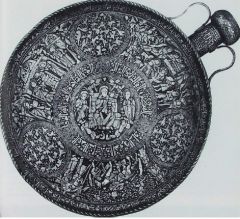
ayyubid brass canteen
|
* atabeg (1100-1300) - ayyubid
* 18 of these objects survive. echo form of crusader canteens. ayyubid metal works. * imagery: mary and christ in center, nativity scene. cruciform halo on christ. nativity, presentation, entry into jerusalem. "prophet jesus" not indicative of christ- crucifixion etc. sura around the sides, workshop name on spout. reaction against crusader art? no name of patron. mass produced. |
|

sultan qu'aitbay funerary complex
|
* mamluk (1250-1517)
*unified facade hides the rest of the interior architecture. elevating a dome by putting it on a drum. pierced by windows, brings in more light. drawing from byzantium. *repetition of mamluk military elements in architectural form. play on one form, here circles. *earlier mausolea in keeping with the prophet's demand for humble burial sites, no huberis. mamluks not very respectful of this. shows a cultural and theological shift. funerary monuments no longer seen as anti religious. *inscriptions on a massive scale. inscriptions: sultan > allah |
|
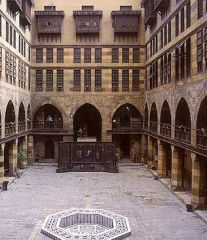
wakala of al-ghuri
|
* mamluk (1250-1517)
* cairo * warehouses, workshops (lower). shops (middle). 3 apartments on upper floor that could be rented from the sultan. one of the larger buildings in cario. spolia: reused architectural elements. roman, fatimid, etc. status, scale, location. sultan's madrasa next door. |
|
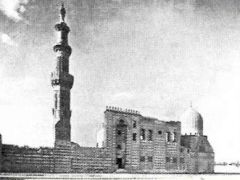
funerary complex of sultan inal
|
* mamluk (1250-1517), 1451-1456
* sultans build their complexes near pharohs in "city of the dead." goes against the prophet's demand for modest burial * helmet type domes, drums with windows, different forms of minarets. *architectural components dialogue between ancient egypt and modern egypt. shows of power. not imitating but rather showing the new power in this area. |
|
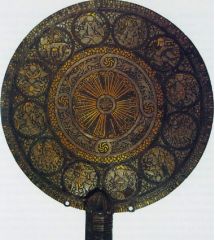
bronze mirror
|
* mamluk (1250-1517)
* gold and silver inlay on one side, highly polished brass on the other side. radiating rays are calligraphy. and list name of patron. blazon lists titles. use of circular form is familiar. cosmokrator, ruler of the universe, is theme. this is seen through the name in the middle and the animals and variations around edges. same interplay seen on architectural exteriors. unified object reflects power of patron and his sultan as well as patron as cosmokrator. signed by artist. prestige of the artist gives prestige to the patron. amirs were regional rulers under sultan. |
|
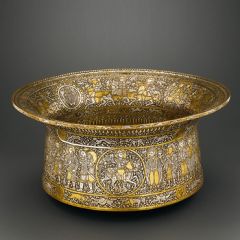
baptistere of saint louis
|
* mamluk (1250-1517)
* spoils of war. all princes and princesses were baptizen in this. originally meant for sultan. * artist: muhammad ibn al-zain. * decorated inside and out, inlayed gold and silver on top of brass, display object for mamluks. oxidation of silver shows the high level of maintenance associated with this object. * seated ruler, blazons. and scenes of military conquest. christian iconography is reflective in altered st. george motif. new interaction between figures. |
|
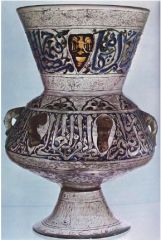
cup bearer lamp
|
* mamluk (1250-1517)
* made of the officer of cup bearer to the sultan. he is named on the neck of the lamp. this would have been donated to the mosque in his name. these donated lamps have never had religious content. act of piety was giving the lamp. * blown glass, painted and almost treated like enamel. blazon has gold leaf and is attached to the lamp. |
|
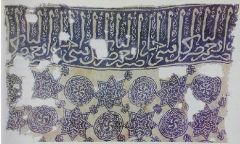
al-nasir linen
|
* mamluk (1250-1517)
* more textiles survive from mamluk area than any other. like glass, they are highly treasured and precious, generally made of silk. red is an extremely expensive dye. * exported to the west. many textiles survive in churches. christian imagery with quran quotes. van eyek painting shown mamluk rug. * linen prized by middle class. you could have your own block print customized with your titles, you could then go to a fabric shop and have it translated into a fabric item. *mamluk calligraphy very vertical in nature |
|
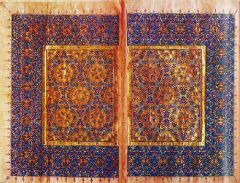
qur'an colophon page
|
* mamluk (1250-1517) : 1372
* use of paper allows for larger books. they are non functional without stand. would have been donated to a foundation and put on display to show piety. script give date, location of creation, and names of patron and artist. a colophon is a very christian practice, which is the last page that information of creation. qur'ans are now reduced to two or three lines per page, resulting in 30 volume "power symbols." gold, cobalt, radiating imagery, reflect kaleidoscope. opening page would have originally had a lot of space which is another indicator of enormous wealth, repetition of solar imagery. letters overlap and ignore decoration. ordered militaristic design contrast with elegant calligraphy. script is the qur'an and more important than decoration. blazons may have evolved from cartouche. if arabic was learned through memorization/repetition of qur'an, was this even necessary to read? |
|
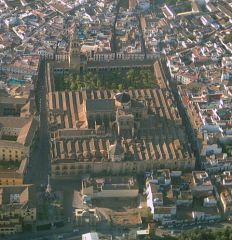
great mosque of cordoba (general)
|
* spanish umayyad (750-1492)
* symbol of legitimacy and highly unified caliphate * different building phases undertaken by the abd-al-rahmans, shows flexibility of a hypostyle plan. originally a church, abd-al-rahman I buys and demolishes. spolia runs out eventually.. remakes fake spolia. |
|
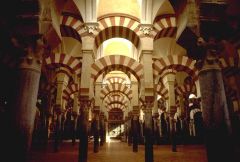
great mosque of cordoba (voussoirs)
|
* spanish umayyad (750-1492)
* striping imitates voussoirs * spanish umayyad (750-1492) * double arcade on top of short pillars. horseshoe arch with kickback, red and white alternating voussoirs: identifying of spanish umayyad architecture. |
|
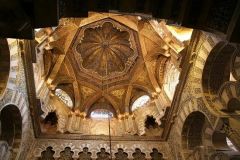
great mosque of cordoba (dome)
|
* spanish umayyad (750-1492)
* maqsura: widened aisles, private praying area in front of the niche, added on, reserved for caliph. * dome marks sacred spot at the end of the maqsura where the caliph stands. * "pumpkin shell" dome = byzantine. |
|
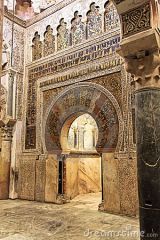
great mosque of cordoba (mihrab)
|
* spanish umayyad (750-1492)
* mosaics: byzantine style. meant to reference umayyad power (think dome of the rock/great mosque of damascus) imitate voussoirs- gold, silver, lapis. floral imagery symbolic of dar al islams great monuments. * mihrab becomes completely separate room. * visual continuity- decoration becomes more elaborate the closer that you get to the mihrab room. * suras from quran in "retro" kufic script. |
|
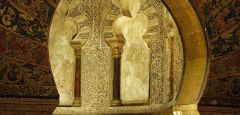
great mosque of cordoba (stucco)
|
* spanish umayyad (750-1492)
* looks back to previous umayyad stucco work |
|
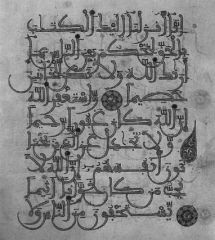
spanish umayyad qur'an
|
* spanish umayyad (750-1492)
* the rest of islamic worl using paper, al-andalus still using vellum. looks back to other umayyad power. * terminal flourishes, loops, shows that scribes are learning whole words. |
|
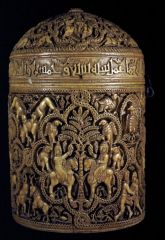
pyxis of al-mughira
|
* spanish umayyad (750-1492)
* incredible detail of carving. inscription: given to the younger son of abd-al-rahman III. two of everything: confronted animals, two princes, etc. to the younger son who is never going to inherit the wealth and power of the caliphate this could be considered a statement of political impotence... |
|
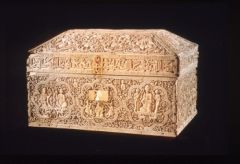
casket of al-malik
|
* spanish umayyad (750-1492)
* made for aristocratic/ elite, but not necessarily the court. supports humorous interpretaion of pyxis of al-mughira. lions attacking the hunter.. who is a northern frank? disrespect for cultures around the spanish umayyads. conspicuous consumption with a message. |
|
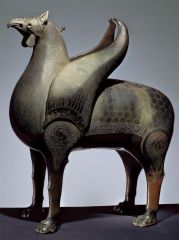
pisa griffin
|
* spanish umayyad (750-1492)
* during reconquista taken as a spoil of war. statement of power. maybe paired? large bronze expensive court object. probably made in a workshop in cordoba. largest surviving bronze from medieval islam. * natural representation of a mythical beast + articulated (division of form into smaller units). unnatural. inscription of qur'an. signed by multiple artists. |
|
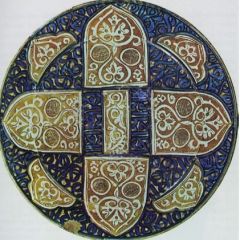
valencian lustreware dish
|
* spanish umayyad (750-1492)
* valencia center of "muslim pottery." prestige objects. tri-colored. secular "good wishes" in script. symmetrical in design. |
|
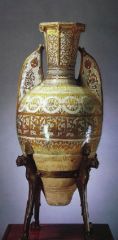
alhambra vase
|
* spanish umayyad (750-1492)
* workshop outside of palace. * 4.5 feet tall. form is representative of archaic greek type of ancient storage vessels. mass produced, decoration secondary. apotropaic "saving hand" and inscriptions for good health, long life, etc. non-specific audience. "the artists hand has embroidered me as a robe of silk." articulation, tree of life/confronted gazelles- peace and prosperity. |
|
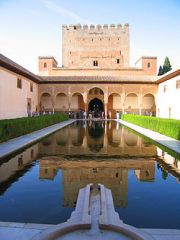
alhambra palace (general)
|
* spanish umayyad (750-1492)
* granada, spain. royal palace, not city, but collection of 6 palaces. built over a span of 40 years by 2 different rulers. * palaces layed out in accordance with nature. on a rocky out cropping overlooking the city. "what the ruler sees." use of water hydraulics, fountains, planted with plants brought from north africa. looks back to baghdad and samarra, jausaq al-khani. legend of abbasid palaces. architectural articulation so that wall space is divided, carved limestone, stucco, tile, glass, wood, etc. emphasis on vertical and the effect of light. |
|
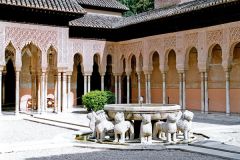
alhambra palace (court of the lions)
|
* spanish umayyad (750-1492)
* granada, spain. royal palace, not city, but collection of 6 palaces. built over a span of 40 years by 2 different rulers. * central large courtyard flanked by four rooms on an axis. private area for the ruler. halls seem to have functioned in terms of acoustics- musicians. utilitarian aspect of islamic architecture- adaptable garden, recycling water through hydraulics. lion is spolia- possibly carolingian or other western. the rest are copied to match. emphasis on carving and verticality. style is different on lions from typical spanish umayyad. |
|
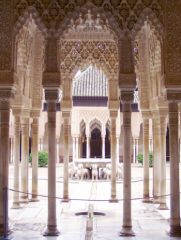
alhambra palace (court of the lions)
|
* spanish umayyad (750-1492)
* granada, spain. royal palace, not city, but collection of 6 palaces. built over a span of 40 years by 2 different rulers. * emphasis on verticality and light shown in the wood carvings. |
|

alhambra palace (hall of the two sisters)
|
* spanish umayyad (750-1492)
* granada, spain. royal palace, not city, but collection of 6 palaces. built over a span of 40 years by 2 different rulers. * marble floor, wall reflecting gold everywhere. tiles, glass inlay. poetry in inscriptions, rather than qur'anic. poetry about nature, stars, beauty. imitates the lavishness of a mihrab. kick back arches almost a horseshoe. insets of gems and glass on golden wall. wall "dissolves" |
|
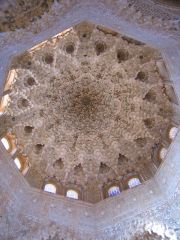
alhambra palace (hall of the two sisters)
|
* spanish umayyad (750-1492)
* granada, spain. royal palace, not city, but collection of 6 palaces. built over a span of 40 years by 2 different rulers. * dome pierced with windows for more natural light. poems about constellations, star shaped domes. honeycomb muquarnes vaulting- no architectural function. packed aspect of every square centimeter. largely non-figural. over 5000 cells in upper vault. rosettes: mshatta. inlays of glass and pearls, many robbed out. |
|
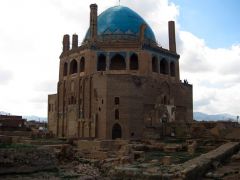
oljeitu tomb
|
* ilkhanids (1219-1336)
* sultaniya, iraq. * canopy tomb, 4 entrances. monumentality like mamluk funerary monuments, tomb of the samanids is another comparison. built on an elevated plateau like dome of the rock. * before gazan khan who made mongols muslim, they were zoroastrians, fire worshippers. linking themselves with previous cultures in the areas that they now occupy. *glazed tiles on outside of architecture-gold/blue. *very little stone construction in this area. mostly mud brick. pointed arches allows for taller buildings. *interior around 180 feet in elevation. *script is in persian, gazan khan takes on the language of court/religion. |
|

candlestick
|
* ilkhanids (1219-1336)
* made for a provencial ruler in the ilkhanate, image of his wife. shows importance of women of aristocracy. wearing the veil that identifies her as a married woman. flowers represent fertility. female attendants. not really referential to depictions of the virgin. contemporary ilkhanate dress. |
|
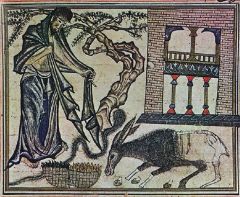
rashid al-din's world history
|
* ilkhanids (1219-1336)
* most prominent minor art of this period: manuscript. variation in iconography shows synthesis of religions. incorporating existing book types: science, literature, maps, etc. * world history story predates islam, probably cessanian or persian. * this scene is "valley of the dry bones" in the old testament and the qur'an. resurrects man and donkey + food. * style is different. shows asian influences. form elongated. mashup of styles. building painted by someone local. * use of baghdad paper 20 x 28 inches. |
|

great mongol shahnama
|
* ilkhanids (1219-1336)
* persian, predated islam. goes all the way back to alexander. shown on cessanian silver plates, depicts a ruler that "does" not just "is seen." "great mongol shahnama." size and quantity of paper. 200 + illustrations. Cessanian hero Bahram Gur. * east asian influences in the trees, clouds, and rising registers. *hero wearing contemporary ilkhanate clothing. carrying mongol curved bow/ riding camel, as opposed to persian bow/ horse. iconography adapted to culture. * woman is an evil influence.. ruler needs to be humble. crowns modeled on cessanian headgear. non muslim, non arabic, non persian culture absorbing this culture. |
|
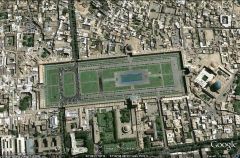
isfahan maidan
|
* safavids (1501-1722)
* isfahan: 4 iwan plan. maidan on plaza. mosque of the shah, 4 iwan also. mamluk dome form, turquoise and blue tile work. caravanserai: safavids and ottomans competing for european trade. maidan was meeting place in middle of city, isfahan as capital of commercial international culture. |
|

shahnama of shah tahmasp
|
* safavids (1501-1722)
* popular literature, continuation of trend. 400 full page illuminations. cutaway scene, different orientation of script, still showing the influence of asia. reverse perspective. blazons mamluk. dancing girls on blazons. compartmentalized/ articulated. |
|
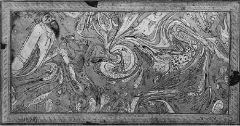
mystic journey
|
* safavids (1501-1722)
* shi'a mystic - twelvers, 85% of modern day shi'a muslims. combination of traditional shi'a and mysticiam. need for dynasty to legitimize itself. shah claims direct descent from the prophet. "twelvers" refer to 12 imams- the 12th being "the hidden one" not yet come, end of the world when the 12th imam comes. * man can merge with the universe via religion. shows asian influence: fish, stork, people, spiritual vision. trippy~ |
|
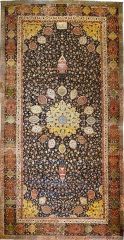
ardabil carpet
|
* safavids (1501-1722)
* two state run carpet factories: kashan and isfahan. center of lustreware production too. * ardabil is in modern day turkey, shrine to sufi saint. * 36 x 18 ft (ish). 33 million knots. no overt religious imagery. religious poem inscribed. solar imagery. pool w/ lotus blossom shows asian influences. hanging lamps on each side: mamluk? oblique approach to religion.. not overt. |
|

safavid ewer
|
* safavid (1501-1722)
* imitation blue and white chinese export ware porcelain. * form and iconography similar as well. made by safavids for european/safavid empire market. ottomans had control of chinese trade routes. both competing for access to european markets. follows form but divided. artist using form of underlying ewer. |
|

haci ozbeck mosque
|
* ottoman (1299-1923)
* domed square * reaction of ottoman empire to the ownership of lands previously owned by Byzantium |
|
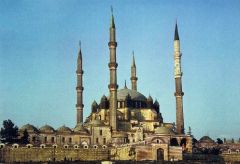
selimiye mosque complex
|
* ottoman (1299-1923) edirne, istanbul
* imperial mosque of sultan selim, architect: sinan (1491-1588) * very different form of mosque architecture, influenced by ascending dome and central plan of hagia sophia. 4 minarets = imperial mosque. much more vertical than hagia sophia. |
|
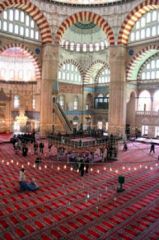
selimiye mosque complex
|
* ottoman (1299-1923) edirne, istanbul
* imperial mosque of sultan selim, architect: sinan (1491-1588) * red and white voussoirs, muqarnes capitals and vaulting, qur'anic inscriptions, iznik tiles. form is byzantine but decoration is representative of all the other cultures dominated by ottoman empire. triumph of calligraphy. solar imagery. paradise, celestial. |
|
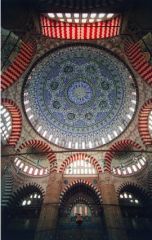
selimiye mosque complex
|
* ottoman (1299-1923) edirne, istanbul
* imperial mosque of sultan selim, architect: sinan (1491-1588) * dome: solar imagery. paradise, celestial. |
|
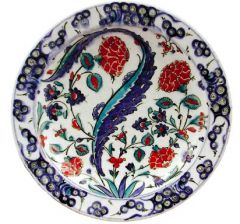
iznikware plate
|
* ottoman (1299-1923)
* government sponsored tile factories, royal monopoly on this type of ceramic. making 20000 pieces of ceramic per week. internal use but also a major export product. *very restricted color palette: red, blues, some black, set on a white background. colors: trade secret, not able to be replicated by people that made fake iznikware. limited iconography as well: flowers, usually tulips, carnations, roses, and fronts. representations of plants native to turkey. copied in italy but not nearly as successful. |
|
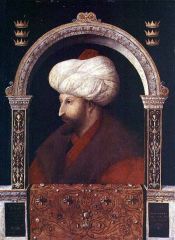
portrait of mehmet II
|
* ottoman (1299-1923)
* bellini working as ottoman court artist, shows interest of the ottoman's in european culture and visa versa. * bellini's portrait becomes a standard type of portrait. |
|
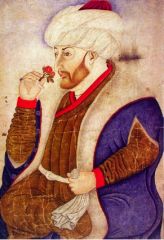
mehmet II smelling a rose
|
* ottoman (1299-1923)
* ottoman version of bellini's portrait. philosopher, contemplating something other than himself. ruler seated crosslegged references princely entertainments. |
|
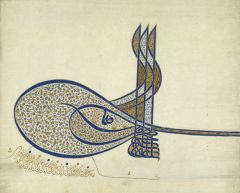
tughra of sultan suleyman
|
* ottoman (1299-1923)
* sultan's name and titles in calligraphic form. meant to be a "portrait" of the sultan. affixed to treaties, confirmed official nature of documents. |

